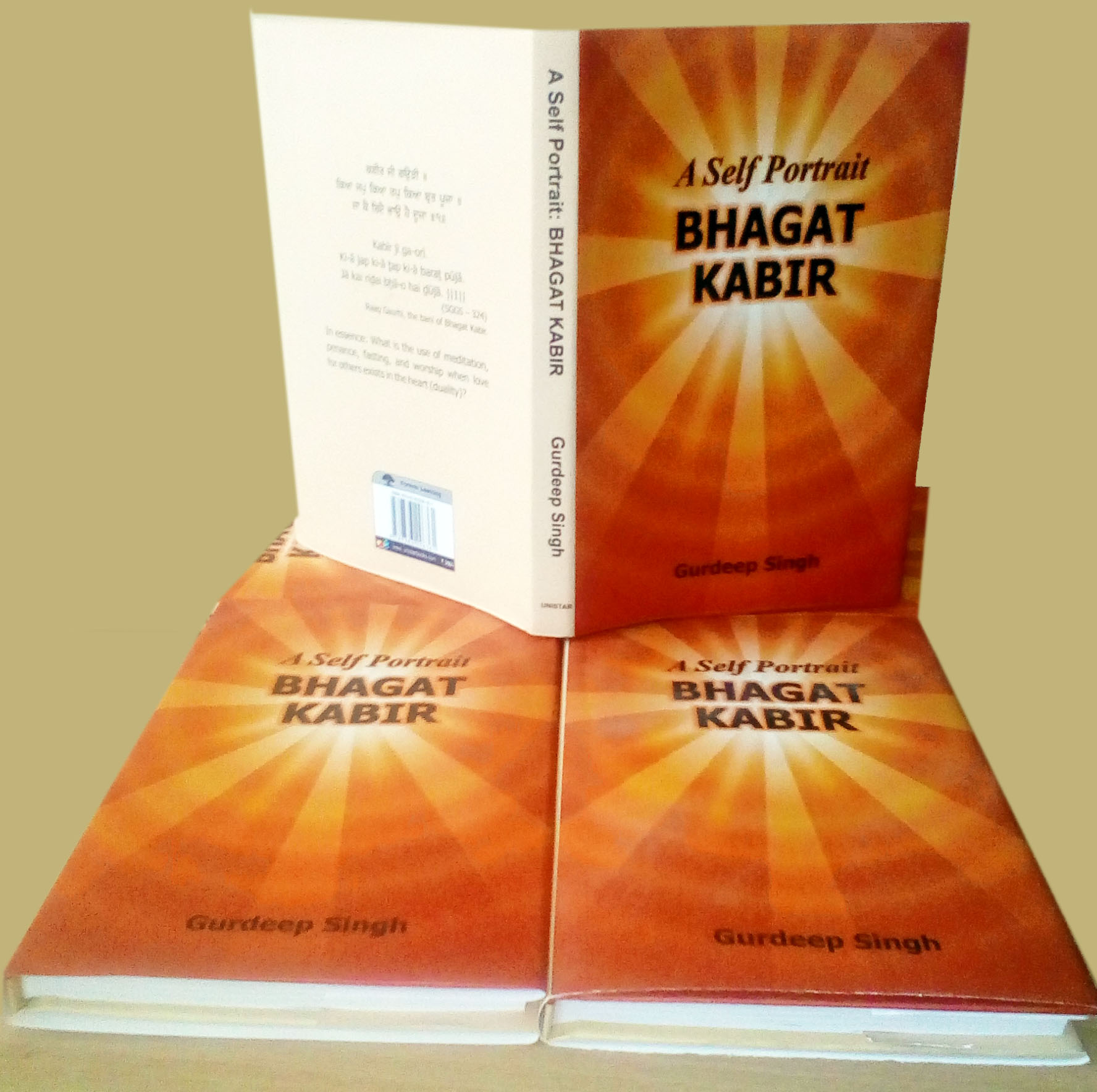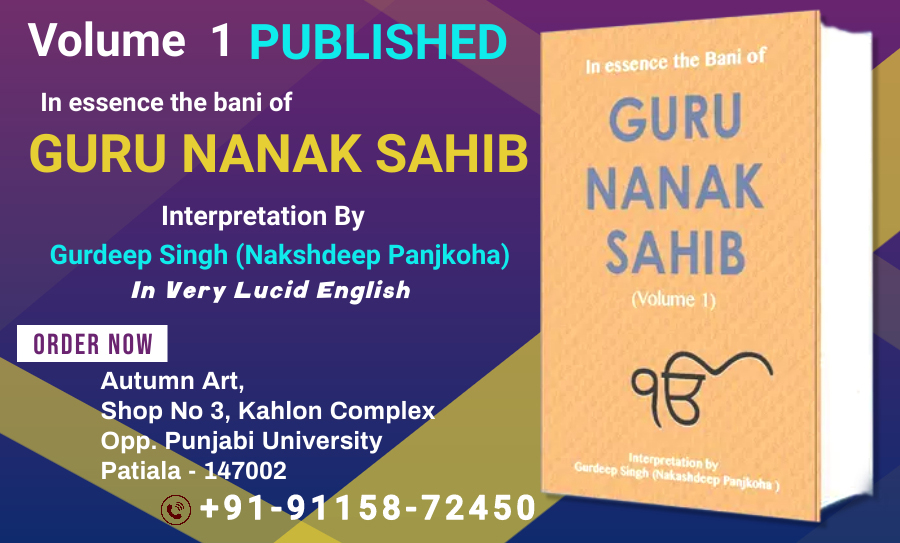The first day of every Indian month is called “Sangrand”. Even today, almost in all Sikh circles, the importance of “Sangrand” is being advocated; if the Guru suggests that days are just days and there is nothing special about them, why we fall for mythical concepts? According to the Guru, everyday is auspicious to remember the Creator or to celebrate Him by praising Him then why should we give all stress on a day called “ Sangrand” ? Is it because the first day of the month needs to be celebrated to please our Creator? Are we enslaved by someone’s thought or are we adamant to accept the fact that we are following those, who thought opposite to the Guru? The Guru talks about the auspicious time, but clearly it is about the time or the moment when we involve in the Creator’s love; here it is on 1123, SGGS:
ਹਰਿ ਦਰਸਿ ਮਨੁ ਲਾਗਾ ਦਿਨਸੁ ਸਭਾਗਾ ਅਨਦਿਨੁ ਹਰਿ ਗੁਣ ਗਾਹੀ ॥
ਨਾਨਕ ਦਾਸੁ ਕਹੈ ਬੇਨੰਤੀ ਕਤ ਹਰਿ ਬਿਨੁ ਪ੍ਰਾਣ ਟਿਕਾਹੀ ॥੨॥
Har ḏaras man lāgā ḏinas sabẖāgā an-ḏin har guṇ gāhī.
Nānak ḏās kahai benanṯī kaṯ har bin parāṇ tikāhī. ||2||
In essence: That day becomes auspicious when one involves in Har’s vision and sings His virtues. Nanak, Har’s servant, humbly says that without Har, it is hard to live on
ਭੈਰਉ ਮਹਲਾ ੪ ॥
ਬੋਲਿ ਹਰਿ ਨਾਮੁ ਸਫਲ ਸਾ ਘਰੀ ॥ ਗੁਰ ਉਪਦੇਸਿ ਸਭਿ ਦੁਖ ਪਰਹਰੀ ॥੧॥
Bẖairo mėhlā 4.
Bol har nām safal sā gẖarī. Gur upḏes sabẖ ḏukẖ parharī. ||1||
{SGGS-1134}
Raag Bhairo, the bani of Fourth Nanak.
In essence: That moment becomes fruitful when Ekankar’s name is uttered; through the Guru’s teachings, all pains are eliminated.
Obviously, it is not the day, or the month but one’s mindset that becomes ready to realize Him through His praise by over coming the Maya influences. The Guru frees the Sikhs from becoming slaves of rituals or keeping fasts or going on pilgrimages on special days or months; however, as his followers, we certainly fail to promote our Guru’s ideology, and bad thing is this that we intend to follow those, who do not get aligned with our Guru.
In the following Bani, the Guru doesn’t give importance to any of the days either; for him, everyday is there to improve spiritually and to learn how to live purely in the Maya dominated world as a lotus flower does in the filthy water.
Let us together understand the Guru’s message in his bani “Thithee”
ਬਿਲਾਵਲੁ ਮਹਲਾ ੧ ਥਿਤੀ ਘਰੁ ੧੦ ਜਤਿ
Bilāval mėhlā 1 thiṯī gẖar 10 jaṯ
{SGGS-838-840}
Raag Bilawal, the bani of First Nanak, the Lonar days house tenth, Jat (Tune).
ੴ ਸਤਿਗੁਰ ਪ੍ਰਸਾਦਿ ॥
Ik-oaʼnkār saṯgur parsāḏ.
There is only one All Pervading Akalpurakh, who is known with the blessings of the Satiguru.
ਏਕਮ ਏਕੰਕਾਰੁ ਨਿਰਾਲਾ ॥ਅਮਰੁ ਅਜੋਨੀ ਜਾਤਿ ਨ ਜਾਲਾ ॥
ਅਗਮ ਅਗੋਚਰੁ ਰੂਪੁ ਨ ਰੇਖਿਆ ॥ ਖੋਜਤ ਖੋਜਤ ਘਟਿ ਘਟਿ ਦੇਖਿਆ ॥
ਜੋ ਦੇਖਿ ਦਿਖਾਵੈ ਤਿਸ ਕਉ ਬਲਿ ਜਾਈ ॥ ਗੁਰ ਪਰਸਾਦਿ ਪਰਮ ਪਦੁ ਪਾਈ ॥੧॥
Ėkam ekankār nirālā. Amar ajonī jāṯ na jālā.
Agam agocẖar rūp na rekẖ-i-ā. Kẖojaṯ kẖojaṯ gẖat gẖat ḏekẖi-ā.
Jo ḏekẖ ḏikẖāvai ṯis ka-o bal jā-ī. Gur parsāḏ param paḏ pā-ī. ||1||
{SGGS-838-839}
In essence: Ekam/Lunar day one: Ekankar is unique (none is like Ekankar). He is eternal; He is beyond birth, caste, and involvements (of Maya as we are in). Ekankar is inaccessible and incomprehensible and He has no form or feature. Through an intensive search, I have seen Him in all. I sacrifice to that person, who after seeing Ekankar makes others see Him. With the blessings of the Guru, a supreme status is obtained.
ਕਿਆ ਜਪੁ ਜਾਪਉ ਬਿਨੁ ਜਗਦੀਸੈ ॥
ਗੁਰ ਕੈ ਸਬਦਿ ਮਹਲੁ ਘਰੁ ਦੀਸੈ ॥੧॥ ਰਹਾਉ ॥
Ki-ā jap jāpa-o bin jagḏīsai.
Gur kai sabaḏ mahal gẖar ḏīsai. ||1|| Rahā-o. {SGGS-839}
Except Ekankar, whom should I remember (means I don’t remember any other entity)? Through the Guru’s shabda, His abode is seen. Pause.
ਦੂਜੈ ਭਾਇ ਲਗੇ ਪਛੁਤਾਣੇ ॥ ਜਮ ਦਰਿ ਬਾਧੇ ਆਵਣ ਜਾਣੇ ॥
ਕਿਆ ਲੈ ਆਵਹਿ ਕਿਆ ਲੇ ਜਾਹਿ ॥ ਸਿਰਿ ਜਮਕਾਲੁ ਸਿ ਚੋਟਾ ਖਾਹਿ ॥
ਬਿਨੁ ਗੁਰ ਸਬਦ ਨ ਛੂਟਸਿ ਕੋਇ ॥ ਪਾਖੰਡਿ ਕੀਨ੍ਹ੍ਹੈ ਮੁਕਤਿ ਨ ਹੋਇ ॥੨॥
Ḏūjai bẖā-e lage pacẖẖuṯāṇe. Jam ḏar bāḏẖe āvaṇ jāṇe.
Ki-ā lai āvahi ki-ā le jāhi. Sir jamkāl sė cẖotā kẖāhi.
Bin gur sabaḏ na cẖẖūtas ko-e. Pakẖand kīnĥai mukaṯ na ho-e. ||2||
In essence: Those who are in love with others will repent, and they, being bound, will keep coming and going. What have they brought when they came into this world and what will they take with them when they go from here? They endure the pain of death and its fear. Without the Guru’s shabda, no one can get liberated. By practicing hypocrisy, no one is liberated.
ਆਪੇ ਸਚੁ ਕੀਆ ਕਰ ਜੋੜਿ ॥ ਅੰਡਜ ਫੋੜਿ ਜੋੜਿ ਵਿਛੋੜਿ ॥
ਧਰਤਿ ਅਕਾਸੁ ਕੀਏ ਬੈਸਣ ਕਉ ਥਾਉ ॥ ਰਾਤਿ ਦਿਨੰਤੁ ਕੀਏ ਭਉ ਭਾਉ ॥
ਜਿਨਿ ਕੀਏ ਕਰਿ ਵੇਖਣਹਾਰਾ ॥ ਅਵਰੁ ਨ ਦੂਜਾ ਸਿਰਜਣਹਾਰਾ ॥੩॥
Āpe sacẖ kī-ā kar joṛ. Andaj foṛ joṛ vicẖẖoṛ.
Ḏẖaraṯ akās kī-e baisaṇ ka-o thā-o. Rāṯ ḏinanṯ kī-e bẖa-o bẖā-o.
Jin kī-e kar vekẖaṇhārā. Avar na ḏūjā sirjaṇhārā. ||3||
In essence: Akalpurakh is eternal and He has created the world. He creates the universe and destroys it. He has created the earth and the sky for us to live; He has created the days, the nights, fear, and love. Akalpurakh, who has created all this, watches it all; there is no other creator but Him.
ਤ੍ਰਿਤੀਆ ਬ੍ਰਹਮਾ ਬਿਸਨੁ ਮਹੇਸਾ ॥ ਦੇਵੀ ਦੇਵ ਉਪਾਏ ਵੇਸਾ ॥
ਜੋਤੀ ਜਾਤੀ ਗਣਤ ਨ ਆਵੈ ॥ ਜਿਨਿ ਸਾਜੀ ਸੋ ਕੀਮਤਿ ਪਾਵੈ ॥
ਕੀਮਤਿ ਪਾਇ ਰਹਿਆ ਭਰਪੂਰਿ ॥ ਕਿਸੁ ਨੇੜੈ ਕਿਸੁ ਆਖਾ ਦੂਰਿ ॥੪॥
Ŧariṯī-ā barahmā bisan mahesā. Ḏevī ḏev upā-e vesā.
Joṯī jāṯī gaṇaṯ na āvai. Jin sājī so kīmaṯ pāvai.
Kīmaṯ pā-e rahi-ā bẖarpūr. Kis neṛai kis ākẖā ḏūr. ||4||
In essence: (Tritya/Third day) Akalpurakh has created Brahma, Shiva and Vishnu and also Devis and devtas of many forms. It is not possible to count His creations. Only Akalpurakh, the Creator, knows the worth of His creation. Yes He values His creation and He is pervading all over fully. I should call whom to be near to Him or far away from Him?
ਚਉਥਿ ਉਪਾਏ ਚਾਰੇ ਬੇਦਾ ॥ ਖਾਣੀ ਚਾਰੇ ਬਾਣੀ ਭੇਦਾ ॥
ਅਸਟ ਦਸਾ ਖਟੁ ਤੀਨਿ ਉਪਾਏ ॥ ਸੋ ਬੂਝੈ ਜਿਸੁ ਆਪਿ ਬੁਝਾਏ ॥
ਤੀਨਿ ਸਮਾਵੈ ਚਉਥੈ ਵਾਸਾ ॥ ਪ੍ਰਣਵਤਿ ਨਾਨਕ ਹਮ ਤਾ ਕੇ ਦਾਸਾ ॥੫॥
Cẖa-uth upā-e cẖāre beḏā. Kẖāṇī cẖāre baṇī bẖeḏā.
Asat ḏasā kẖat ṯīn upā-e. So būjẖai jis āp bujẖā-e.
Ŧīn samāvai cẖa-uthai vāsā. Paraṇvaṯ Nānak ham ṯā ke ḏāsā. ||5||
In essence: (Fourth day) Akalpurakh has created the four Vedas, the four sources of lives, and their different forms of speech (It means everything is because of His Will; it doesn’t mean the Creator specially created Vedas only, because He also created those who commit crimes). He has created the eighteen Shastras and the three modes (qualities) of Maya. Only that person to whom Akalpurakh gives all that understanding comprehends this. Such a person goes above (the influences of) the three qualities of Maya and settles in the fourth state. Nanak humbly says that he is a slave of that person, who settles in the fourth state.
ਪੰਚਮੀ ਪੰਚ ਭੂਤ ਬੇਤਾਲਾ ॥ ਆਪਿ ਅਗੋਚਰੁ ਪੁਰਖੁ ਨਿਰਾਲਾ ॥
ਇਕਿ ਭ੍ਰਮਿ ਭੂਖੇ ਮੋਹ ਪਿਆਸੇ ॥ ਇਕਿ ਰਸੁ ਚਾਖਿ ਸਬਦਿ ਤ੍ਰਿਪਤਾਸੇ ॥
ਇਕਿ ਰੰਗਿ ਰਾਤੇ ਇਕਿ ਮਰਿ ਧੂਰਿ ॥ ਇਕਿ ਦਰਿ ਘਰਿ ਸਾਚੈ ਦੇਖਿ ਹਦੂਰਿ ॥੬॥
Pancẖmī pancẖ bẖūṯ beṯālā. Āp agocẖar purakẖ nirālā.
Ik bẖaram bẖūkẖe moh pi-āse. Ik ras cẖākẖ sabaḏ ṯaripṯāse.
Ik rang rāṯe ik mar ḏẖūr. Ik ḏar gẖar sācẖai ḏekẖ haḏūr. ||6||
In essence: (Punchmi/fifth lunar day) The mortal is trapped in the five negative passions that act like demons, but Akalpurakh is detached and incomprehensible. There are some people, who are in doubts, attachments and desires, but there are some others, who taste Akalpurakh’s name essence through the Guru’s shabda and get satiated. There are some people, who are drenched in His love, but there are others, who end up in dust (become worthless); there are some people, who are with Him and see Him ever present.
ਝੂਠੇ ਕਉ ਨਾਹੀ ਪਤਿ ਨਾਉ ॥ ਕਬਹੁ ਨ ਸੂਚਾ ਕਾਲਾ ਕਾਉ ॥
ਪਿੰਜਰਿ ਪੰਖੀ ਬੰਧਿਆ ਕੋਇ ॥ ਛੇਰੀਂ ਭਰਮੈ ਮੁਕਤਿ ਨ ਹੋਇ ॥
ਤਉ ਛੂਟੈ ਜਾ ਖਸਮੁ ਛਡਾਏ ॥ ਗੁਰਮਤਿ ਮੇਲੇ ਭਗਤਿ ਦ੍ਰਿੜਾਏ ॥੭॥
Jẖūṯẖe ka-o nāhī paṯ nā-o. Kabahu na sūcẖā kālā kā-o.
Pinjar pankẖī banḏẖi-ā ko-e. Cẖẖerīʼn bẖarmai mukaṯ na ho-e.
Ŧa-o cẖẖūtai jā kẖasam cẖẖadā-e. Gurmaṯ mele bẖagaṯ driṛ-ā-e. ||7||
In essence: A person who is attached to falsehood (Maya) has no honor; such a person, blackened like crow with vices, cannot become pure. Thus the Maya binds such a person like a bird in the cage and he wanders in Maya only; in doubts, he cannot be liberated; he can be liberated only if Ekankar releases him from the bonds of Maya by uniting him with the Guru’s teachings which implant Ekankar’s devotion in him.
ਖਸਟੀ ਖਟੁ ਦਰਸਨ ਪ੍ਰਭ ਸਾਜੇ ॥ ਅਨਹਦ ਸਬਦੁ ਨਿਰਾਲਾ ਵਾਜੇ ॥
ਜੇ ਪ੍ਰਭ ਭਾਵੈ ਤਾ ਮਹਲਿ ਬੁਲਾਵੈ ॥ ਸਬਦੇ ਭੇਦੇ ਤਉ ਪਤਿ ਪਾਵੈ ॥
ਕਰਿ ਕਰਿ ਵੇਸ ਖਪਹਿ ਜਲਿ ਜਾਵਹਿ ॥ ਸਾਚੈ ਸਾਚੇ ਸਾਚਿ ਸਮਾਵਹਿ ॥੮॥
Kẖastī kẖat ḏarsan parabẖ sāje. Anhaḏ sabaḏ nirālā vāje.
Je parabẖ bẖāvai ṯā mahal bulāvai. Sabḏe bẖeḏe ṯa-o paṯ pāvai.
Kar kar ves kẖapėh jal jāvėh. Sācẖai sācẖe sācẖ samāvėh. ||8||
In essence: (Khasti/Sixth Lunar day) Prabh has created the sixth Systems, but an unstuck melody of His praise resounds apart from these Systems. If Prabh is pleased, He calls the mortal to His abode; when one involves with the shabda of His praise, one obtains respect, otherwise, others get weary of wearing religious robes and burn in Maya. Those who are involved with Prabh merge with Him.
ਸਪਤਮੀ ਸਤੁ ਸੰਤੋਖੁ ਸਰੀਰਿ ॥ ਸਾਤ ਸਮੁੰਦ ਭਰੇ ਨਿਰਮਲ ਨੀਰਿ ॥
ਮਜਨੁ ਸੀਲੁ ਸਚੁ ਰਿਦੈ ਵੀਚਾਰਿ ॥ ਗੁਰ ਕੈ ਸਬਦਿ ਪਾਵੈ ਸਭਿ ਪਾਰਿ ॥
ਮਨਿ ਸਾਚਾ ਮੁਖਿ ਸਾਚਉ ਭਾਇ ॥ ਸਚੁ ਨੀਸਾਣੈ ਠਾਕ ਨ ਪਾਇ ॥੯॥
Sapṯamī saṯ sanṯokẖ sarīr. Sāṯ samunḏ bẖare nirmal nīr.
Majan sīl sacẖ riḏai vīcẖār. Gur kai sabaḏ pāvai sabẖ pār.
Man sācẖā mukẖ sācẖa-o bẖā-e. Sacẖ nīsāṇai ṯẖāk na pā-e. ||9||
In essence: (lunar day seventh) Those persons, who are contented, who do community service and control their five passions and who clean themselves through high morality and ethics by reflecting on Har in the heart, ferry across through the Guru’s shabda. They keep Har in their hearts and His name on their mouths in His love; they obtain His name–pass for His court; therefore, nothing becomes an obstacle in their way.
ਅਸਟਮੀ ਅਸਟ ਸਿਧਿ ਬੁਧਿ ਸਾਧੈ ॥ ਸਚੁ ਨਿਹਕੇਵਲੁ ਕਰਮਿ ਅਰਾਧੈ ॥
ਪਉਣ ਪਾਣੀ ਅਗਨੀ ਬਿਸਰਾਉ ॥ ਤਹੀ ਨਿਰੰਜਨੁ ਸਾਚੋ ਨਾਉ ॥
ਤਿਸੁ ਮਹਿ ਮਨੂਆ ਰਹਿਆ ਲਿਵ ਲਾਇ ॥ ਪ੍ਰਣਵਤਿ ਨਾਨਕੁ ਕਾਲੁ ਨ ਖਾਇ ॥੧੦॥
Astamī asat siḏẖ buḏẖ sāḏẖai. Sacẖ nihkeval karam arāḏẖai.
Pa-uṇ pāṇī agnī bisrā-o. Ŧahī niranjan sācẖo nā-o.
Ŧis mėh manū-ā rahi-ā liv lā-e. Paraṇvaṯ Nānak kāl na kẖā-e. ||10||
In essence: (Ashtmi/eighth lunar day): One who instead of going after eight psychic powers, controls one’s intellect and involves in the praise of the immaculate Ekankar remains above the three qualities of Maya with His grace. In such a person abides the immaculate Ekankar. Oh Nanak! A person who remains meditated on Him rises above the fear of death (it just doesn’t bother one).
ਨਾਉ ਨਉਮੀ ਨਵੇ ਨਾਥ ਨਵ ਖੰਡਾ ॥ ਘਟਿ ਘਟਿ ਨਾਥੁ ਮਹਾ ਬਲਵੰਡਾ ॥
ਆਈ ਪੂਤਾ ਇਹੁ ਜਗੁ ਸਾਰਾ ॥ ਪ੍ਰਭ ਆਦੇਸੁ ਆਦਿ ਰਖਵਾਰਾ ॥
ਆਦਿ ਜੁਗਾਦੀ ਹੈ ਭੀ ਹੋਗੁ ॥ ਓਹੁ ਅਪਰੰਪਰੁ ਕਰਣੈ ਜੋਗੁ ॥੧੧॥
Nā-o na-umī nave nāth nav kẖanda. Gẖat gẖat nāth mahā balvandā.
Ā-ī pūṯā ih jag sārā. Parabẖ āḏes āḏ rakẖvārā.
Āḏ jugāḏī hai bẖī hog. Oh aprampar karṇai jog. ||11||
{SGGS-839-840}
In essence: (Naomi/Ninth Lunar day): The real Yogi is Akalpurakh, who permeates the nine regions, and who is the Supreme Master; this world has emanated from Him (Akalpurakh is the origin of all). We should bow to Him; He is our Protector. He has been here since the beginning and through all ages. He is here today and He will be here in the future too. He is infinite and omnipotent.
ਦਸਮੀ ਨਾਮੁ ਦਾਨੁ ਇਸਨਾਨੁ ॥ ਅਨਦਿਨੁ ਮਜਨੁ ਸਚਾ ਗੁਣ ਗਿਆਨੁ ॥
ਸਚਿ ਮੈਲੁ ਨ ਲਾਗੈ ਭ੍ਰਮੁ ਭਉ ਭਾਗੈ ॥ ਬਿਲਮੁ ਨ ਤੂਟਸਿ ਕਾਚੈ ਤਾਗੈ ॥
ਜਿਉ ਤਾਗਾ ਜਗੁ ਏਵੈ ਜਾਣਹੁ ॥ ਅਸਥਿਰੁ ਚੀਤੁ ਸਾਚਿ ਰੰਗੁ ਮਾਣਹੁ ॥੧੨॥
Ḏasmī nām ḏān isnān. An-ḏin majan sacẖā guṇ gi-ān.
Sacẖ mail na lāgai bẖaram bẖa-o bẖāgai. Bilam na ṯūtas kācẖai ṯāgai.
Ji-o ṯāgā jag evai jāṇhu. Asthir cẖīṯ sācẖ rang māṇhu. ||12||
In essence: (Tenth Lunar day) Remembering Prabh’s name is equal to giving away charity and doing ablution; having His divine knowledge is a cleaning process because of which no filth of Maya attaches to the mind. Instead with it, one’s fear and doubt go away as the flimsy thread takes no time to break up. Deem the world as the flimsy thread; keep the mind stilled with Prabh and enjoy His bliss.
ਏਕਾਦਸੀ ਇਕੁ ਰਿਦੈ ਵਸਾਵੈ ॥ ਹਿੰਸਾ ਮਮਤਾ ਮੋਹੁ ਚੁਕਾਵੈ ॥
ਫਲੁ ਪਾਵੈ ਬ੍ਰਤੁ ਆਤਮ ਚੀਨੈ ॥ ਪਾਖੰਡਿ ਰਾਚਿ ਤਤੁ ਨਹੀ ਬੀਨੈ ॥
ਨਿਰਮਲੁ ਨਿਰਾਹਾਰੁ ਨਿਹਕੇਵਲੁ ॥ ਸੂਚੈ ਸਾਚੇ ਨਾ ਲਾਗੈ ਮਲੁ ॥੧੩॥
Ėkāḏasī ik riḏai vasāvai. Hinsā mamṯā moh cẖukẖāvai.
Fal pāvai baraṯ āṯam cẖīnai. Pakẖand rācẖ ṯaṯ nahī bīnai.
Nirmal nirāhār nihkeval. Sūcẖai sācẖe nā lāgai mal. ||13||
In essence: (Ekadsi/Eleventh Lunar day): One who keeps only Akalpurakh in one’s heart, who gets rid of cruelty and attachment and who realizes one’s “inner self” has performed fasting. By practicing hypocrisy (like doing fasts and other rituals), one cannot realize Akalpurakh. The immaculate Creator doesn’t need food and He is above the Maya filth.
ਜਹ ਦੇਖਉ ਤਹ ਏਕੋ ਏਕਾ ॥ ਹੋਰਿ ਜੀਅ ਉਪਾਏ ਵੇਕੋ ਵੇਕਾ ॥
ਫਲੋਹਾਰ ਕੀਏ ਫਲੁ ਜਾਇ ॥ ਰਸ ਕਸ ਖਾਏ ਸਾਦੁ ਗਵਾਇ ॥
ਕੂੜੈ ਲਾਲਚਿ ਲਪਟੈ ਲਪਟਾਇ ॥ ਛੂਟੈ ਗੁਰਮੁਖਿ ਸਾਚੁ ਕਮਾਇ ॥੧੪॥
Jah ḏekẖ-a-u ṯah eko ekā. Hor jī-a upā-e veko vekā.
Falohār kī-e fal jā-e. Ras kas kẖā-e sāḏ gavā-e.
Kūrhai lālacẖ laptai laptā-e. Cẖẖūtai gurmukẖ sācẖ kamā-e. ||14||
In essence: Wherever I look, I see only Akalpurakh; He has created other lives of various kinds. By eating just the fruits on eleventh fasting lunar day, no fruit is obtained. By eating delicacies, one loses taste (of fasting), this way one remains engrossed in false greed; however, through the Guru, one can get rid of one’s such bonds by meditating on Akalpurakh.
ਦੁਆਦਸਿ ਮੁਦ੍ਰਾ ਮਨੁ ਅਉਧੂਤਾ ॥ ਅਹਿਨਿਸਿ ਜਾਗਹਿ ਕਬਹਿ ਨ ਸੂਤਾ ॥
ਜਾਗਤੁ ਜਾਗਿ ਰਹੈ ਲਿਵ ਲਾਇ ॥ ਗੁਰ ਪਰਚੈ ਤਿਸੁ ਕਾਲੁ ਨ ਖਾਇ ॥
ਅਤੀਤ ਭਏ ਮਾਰੇ ਬੈਰਾਈ ॥ ਪ੍ਰਣਵਤਿ ਨਾਨਕ ਤਹ ਲਿਵ ਲਾਈ ॥੧੫॥
Ḏu-āḏas muḏrā man a-uḏẖūṯā. Ahinis jāgėh kabėh na sūṯā.
Jāgaṯ jāg rahai liv lā-e. Gur parcẖai ṯis kāl na kẖā-e.
Aṯīṯ bẖa-e māre bairā-ī. Paraṇvaṯ Nānak ṯah liv lā-ī. ||15||
In essence: (Duadis/Twelfth Lunar day) A person who remains awake from the Maya influences and who never becomes unaware of its strength by meditating on Akalpurakh is really a detached one; thus one’s life is having all twelve signs; one remains involved with the Guru and the death doesn’t bother one. Nanak humbly says that a person who meditates on Akalpurakh becomes detached and gets rid of all evil-intentions.
ਦੁਆਦਸੀ ਦਇਆ ਦਾਨੁ ਕਰਿ ਜਾਣੈ ॥ ਬਾਹਰਿ ਜਾਤੋ ਭੀਤਰਿ ਆਣੈ ॥
ਬਰਤੀ ਬਰਤ ਰਹੈ ਨਿਹਕਾਮ ॥ ਅਜਪਾ ਜਾਪੁ ਜਪੈ ਮੁਖਿ ਨਾਮ ॥
ਤੀਨਿ ਭਵਣ ਮਹਿ ਏਕੋ ਜਾਣੈ ॥ ਸਭਿ ਸੁਚਿ ਸੰਜਮ ਸਾਚੁ ਪਛਾਣੈ ॥੧੬॥
Ḏu-āḏasī ḏa-i-ā ḏān kar jāṇai. Bāhar jāṯo bẖīṯar āṇai.
Barṯī baraṯ rahai nihkām. Ajpā jāp japai mukẖ nām.
Ŧīn bẖavaṇ mėh eko jāṇai. Sabẖ sucẖ sanjam sācẖ pacẖẖāṇai. ||16||
In essence: (Duadsi/Twelfth Lunar vday): One who knows how to show compassion toward others and keeps one’s mind stilled within observes real fasting. Thus one, by becoming immaculate, remembers His name in one’s heart and sees the same Akalpurakh in the three worlds. This is the way one obtains all purity and self-restraining by realizing Akalpurakh.
ਤੇਰਸਿ ਤਰਵਰ ਸਮੁਦ ਕਨਾਰੈ ॥ ਅੰਮ੍ਰਿਤੁ ਮੂਲੁ ਸਿਖਰਿ ਲਿਵ ਤਾਰੈ ॥
ਡਰ ਡਰਿ ਮਰੈ ਨ ਬੂਡੈ ਕੋਇ ॥ ਨਿਡਰੁ ਬੂਡਿ ਮਰੈ ਪਤਿ ਖੋਇ ॥
ਡਰ ਮਹਿ ਘਰੁ ਘਰ ਮਹਿ ਡਰੁ ਜਾਣੈ ॥ ਤਖਤਿ ਨਿਵਾਸੁ ਸਚੁ ਮਨਿ ਭਾਣੈ ॥੧੭॥
Ŧeras ṯarvar samuḏ kanārai. Amriṯ mūl sikẖar liv ṯārai.
Dar dar marai na būdai ko-e. Nidar būd marai paṯ kẖo-e.
Dar mėh gẖar gẖar mėh dar jāṇai. Ŧakẖaṯ nivās sacẖ man bẖāṇai. ||17||
In essence: (Teris/Thirteen Lunar day): The human body is like a tree on the seashore. One who uses Ekankar’s name as the perfect support of life doesn’t remain in fear; one doesn’t go astray. (Contrary to that) One who has no fear of Ekankar gets drowned in Maya and loses one’s honor. One who bears fear and respect for Ekankar in the heart obtains a place on His eternal throne; this way, Ekankar becomes pleasing to one.
ਚਉਦਸਿ ਚਉਥੇ ਥਾਵਹਿ ਲਹਿ ਪਾਵੈ ॥ ਰਾਜਸ ਤਾਮਸ ਸਤ ਕਾਲ ਸਮਾਵੈ ॥
ਸਸੀਅਰ ਕੈ ਘਰਿ ਸੂਰੁ ਸਮਾਵੈ ॥ ਜੋਗ ਜੁਗਤਿ ਕੀ ਕੀਮਤਿ ਪਾਵੈ ॥
ਚਉਦਸਿ ਭਵਨ ਪਾਤਾਲ ਸਮਾਏ ॥ ਖੰਡ ਬ੍ਰਹਮੰਡ ਰਹਿਆ ਲਿਵ ਲਾਏ ॥੧੮॥
Cẖa-uḏas cẖa-uthe thāvėh lėh pāvai. Rājas ṯāmas saṯ kāl samāvai.
Sasī-ar kai gẖar sūr samāvai. Jog jugaṯ kī kīmaṯ pāvai.
Cẖa-uḏas bẖavan pāṯāl samā-e. Kẖand barahmand rahi-ā liv lā-e. ||18||
In essence: (Chaudis/Fourteenth Lunar day): A person who obtains the fourth state of mind (where the three qualities of Maya do not affect) negates the effect of Maya completely. In there, the heat of desires is cooled off because of the peace in the mind; thus one realizes how to be with Akalpurakh and to value to be one with Him. Then one remains meditated on Akalpurakh who permeates the fourteen worlds and the nether regions.
ਅਮਾਵਸਿਆ ਚੰਦੁ ਗੁਪਤੁ ਗੈਣਾਰਿ ॥ ਬੂਝਹੁ ਗਿਆਨੀ ਸਬਦੁ ਬੀਚਾਰਿ ॥
ਸਸੀਅਰੁ ਗਗਨਿ ਜੋਤਿ ਤਿਹੁ ਲੋਈ ॥ ਕਰਿ ਕਰਿ ਵੇਖੈ ਕਰਤਾ ਸੋਈ ॥
ਗੁਰ ਤੇ ਦੀਸੈ ਸੋ ਤਿਸ ਹੀ ਮਾਹਿ ॥ ਮਨਮੁਖਿ ਭੂਲੇ ਆਵਹਿ ਜਾਹਿ ॥੧੯॥
Amāvasi-ā cẖanḏ gupaṯ gaiṇār. Būjẖhu gi-ānī sabaḏ bīcẖār.
Sasī-ar gagan joṯ ṯihu lo-ī. Kar kar vekẖai karṯā so-ī.
Gur ṯe ḏīsai so ṯis hī māhi. Manmukẖ bẖūle āvahi jāhi. ||19||
In essence: (Amvisya/Moon’s lunar day) Oh wise man! At night on Amassya, the moon remains invisible; otherwise, the same Moon illuminates the world at night; in the same way, Akalpurakh remains invisible though He illuminates the world; reflect on the Guru’s Shabda to understand Akalpurakh. It is Akalpurakh, who creates and watches everything. He is in the heart, but through the Guru, He is realized. A person who sees Akalpurakh through the Guru remains meditated on Him; however, the mind-slaves go astray and keep coming and going.
ਘਰੁ ਦਰੁ ਥਾਪਿ ਥਿਰੁ ਥਾਨਿ ਸੁਹਾਵੈ ॥ ਆਪੁ ਪਛਾਣੈ ਜਾ ਸਤਿਗੁਰੁ ਪਾਵੈ ॥
ਜਹ ਆਸਾ ਤਹ ਬਿਨਸਿ ਬਿਨਾਸਾ ॥ ਫੂਟੈ ਖਪਰੁ ਦੁਬਿਧਾ ਮਨਸਾ ॥
ਮਮਤਾ ਜਾਲ ਤੇ ਰਹੈ ਉਦਾਸਾ ॥ ਪ੍ਰਣਵਤਿ ਨਾਨਕ ਹਮ ਤਾ ਕੇ ਦਾਸਾ ॥੨੦॥੧॥
Gẖar ḏar thāp thir thān suhāvai. Āp pacẖẖāṇai jā saṯgur pāvai.
Jah āsā ṯah binas bināsā. Fūtai kẖapar ḏubiḏẖā mansā.
Mamṯā jāl ṯe rahai uḏāsā. Paraṇvaṯ Nānak ham ṯā ke ḏāsā. ||20||1||
In essence: One who obtains the Satiguru realizes one’s “inner-self” and stills one’s mind within by focusing on Akalpurakh firmly. Then the hopes, which used to be in one’s heart, vanish; one’s mentality of claims and duality end and one remains away from the bonds of Maya. Nanak humbly says that he is a servant of such a person.
The Guru’s advice in a nutshell is: let the every day dawn in and be ready for it to make virtuous changes within which can be helpful to focus on the Creator. Don’t let the rituals enslave you, because the rituals were forged in commercials gains and hypocrisy and the Creator wants only your love, which should be higher of any love you are colored with. His love will not let you get filthy and you will live with a stilled mind. Only this way, you will enjoy the freedom the Guru has given you, because you are born to be free; it is the worldly Maya influences that enslave you. The Creator who created you also has blessed you with the power to defeat the Maya influences; utilize it by falling in love with Him.
Wishes
G Singh





